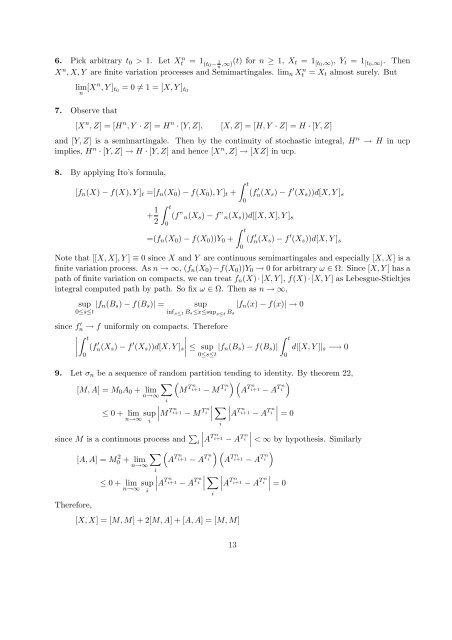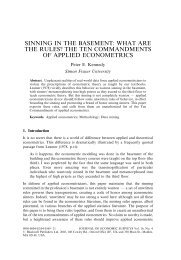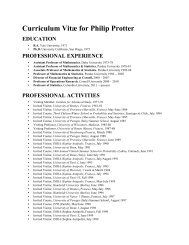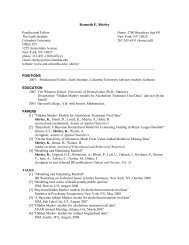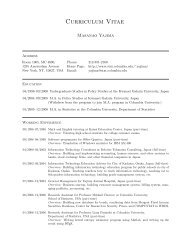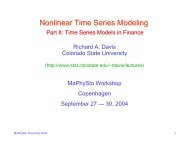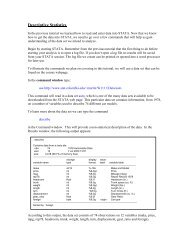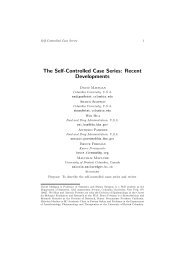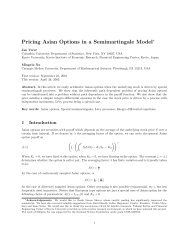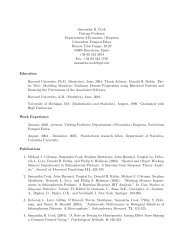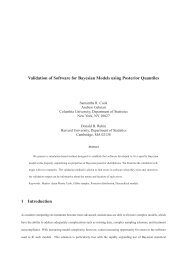Solution to selected problems.
Solution to selected problems.
Solution to selected problems.
You also want an ePaper? Increase the reach of your titles
YUMPU automatically turns print PDFs into web optimized ePapers that Google loves.
6. Pick arbitrary t 0 > 1. Let Xt n = 1 (t0 − 1 ,∞)(t) for n ≥ 1, X t = 1 [t0 ,∞), Y t = 1 [t0 ,∞). Then<br />
n<br />
X n , X, Y are finite variation processes and Semimartingales. lim n Xt<br />
n = X t almost surely. But<br />
lim<br />
n<br />
[X n , Y ] t0 = 0 ≠ 1 = [X, Y ] t0<br />
7. Observe that<br />
[X n , Z] = [H n , Y · Z] = H n · [Y, Z], [X, Z] = [H, Y · Z] = H · [Y, Z]<br />
and [Y, Z] is a semimartingale. Then by the continuity of s<strong>to</strong>chastic integral, H n → H in ucp<br />
implies, H n · [Y, Z] → H · [Y, Z] and hence [X n , Z] → [XZ] in ucp.<br />
8. By applying I<strong>to</strong>’s formula,<br />
[f n (X) − f(X), Y ] t =[f n (X 0 ) − f(X 0 ), Y ] t +<br />
+ 1 2<br />
∫ t<br />
0<br />
∫ t<br />
(f” n (X s ) − f” n (X s ))d[[X, X], Y ] s<br />
=(f n (X 0 ) − f(X 0 ))Y 0 +<br />
0<br />
∫ t<br />
0<br />
(f ′ n(X s ) − f ′ (X s ))d[X, Y ] s<br />
(f ′ n(X s ) − f ′ (X s ))d[X, Y ] s<br />
Note that [[X, X], Y ] ≡ 0 since X and Y are continuous semimartingales and especially [X, X] is a<br />
finite variation process. As n → ∞, (f n (X 0 )−f(X 0 ))Y 0 → 0 for arbitrary ω ∈ Ω. Since [X, Y ] has a<br />
path of finite variation on compacts, we can treat f n (X) · [X, Y ], f(X) · [X, Y ] as Lebesgue-Stieltjes<br />
integral computed path by path. So fix ω ∈ Ω. Then as n → ∞,<br />
sup |f n (B s ) − f(B s )| = sup |f n (x) − f(x)| → 0<br />
0≤s≤t<br />
inf s≤t B s≤x≤sup s≤t B s<br />
since f n ′ → f uniformly on compacts. Therefore<br />
∫ t<br />
∣ ∣∣∣ ∣ (f n(X ′ s ) − f ′ (X s ))d[X, Y ] s ≤ sup |f n (B s ) − f(B s )|<br />
0≤s≤t<br />
0<br />
∫ t<br />
0<br />
d|[X, Y ]| s −→ 0<br />
9. Let σ n be a sequence of random partition tending <strong>to</strong> identity. By theorem 22,<br />
∑ (<br />
) (<br />
)<br />
[M, A] = M 0 A 0 + lim M T i+1 n − M<br />
Ti<br />
n A T i+1 n − A<br />
Ti<br />
n<br />
n→∞<br />
i<br />
∣<br />
≤ 0 + lim<br />
sup<br />
n→∞ i<br />
∣<br />
∣M T i+1 n − M<br />
Ti<br />
n<br />
∣ ∑ i<br />
∣<br />
∣A T n i+1 − A<br />
T n i<br />
∣ = 0<br />
since M is a continuous process and ∑ ∣<br />
i ∣A T i+1 n − A<br />
Ti<br />
n ∣ < ∞ by hypothesis. Similarly<br />
∑ (<br />
) (<br />
)<br />
[A, A] = M0 2 + lim A T i+1 n − A<br />
Ti<br />
n A T i+1 n − A<br />
Ti<br />
n<br />
n→∞<br />
Therefore,<br />
≤ 0 + lim<br />
sup<br />
n→∞ i<br />
i<br />
∣<br />
∣A T i+1 n − A<br />
Ti<br />
n<br />
∣ ∑ i<br />
[X, X] = [M, M] + 2[M, A] + [A, A] = [M, M]<br />
∣<br />
∣A T n i+1 − A<br />
T n i<br />
∣ = 0<br />
13


